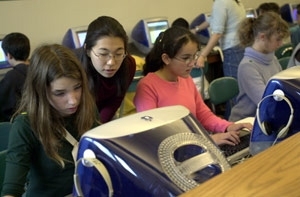A recent collaboration between MIT and an elementary school in Cambridge succeeded both in bringing the inexact science of science to life in the classroom and leaving fifth- and seventh-grade students hungry to learn more about modeling complex systems on computers.
The program was orchestrated by Assistant Professor Eric Klopfer of urban studies and planning, director of the MIT Teacher Education Program, in collaboration with Sybil Knight, principal of the Agassiz School, and Espedito Rivera, a computer teacher at Agassiz. The program was conducted at the school from January through March.
"The program was designed to teach kids to create and explore their own computer models of systems. In doing so, we hoped to teach the students several things about science, technology and the relationships between these domains," Klopfer said.
"First, we wanted to empower kids to be creators, not just consumers, of technology. Second, we wanted to enable students to use technology to explore ideas in science. Finally, and most importantly, we wanted to provide the students with a context for exploring what we call the 'real scientific method,'" he said.
Commenting on the "real scientific method," Klopfer noted, "Scientists do not come up with a hypothesis, conduct experiments and gather results in the linear way that is often conveyed by typical labs. Instead, it is a highly iterative process where you explore a system, start an experiment, learn some more, modify your experiment, take some data, further modify the design, and so on."
The MIT-Agassiz collaboration depended not only on innovativeness and mutual goodwill among administrators, teachers and students, but also on StarLogo, a programming language developed at the MIT Media Lab by Professor Mitchel Resnick.
StarLogo is a computer language that is designed to allow students to investigate and explore models of systems. Students can develop a deeper understanding of processes and patterns in the world around them as they build and explore models of such things as ecological systems, physical phenomena and social dynamics, Kloper noted.
"Through StarLogo, students get a chance to take over the technology and program it to do what they want it to do," Klopfer said. "Too often computers are relegated to the purpose of information search and retrieval. The StarLogo project enabled students to create and explore ideas ranging from traffic jams to insect behavior."
Klopfer and four MIT undergraduate student assistants used the "Adventures in Modeling" curriculum, developed at MIT, to guide students through a series of design challenges that helped them create and explore a wide array of models.
For example, one challenge was to build a model where creatures interact with their environment. One student might choose to build a model of a ball bouncing off of a wall, while another might create a model of a rabbit eating grass.
In addition to the classroom work, children could upload their projects onto the web for their classmates to see, forming a learning and sharing community.
"The students could also learn from one another's work and incorporate new ideas into their own programs. This has been apparent as one student makes a programming innovation that quickly spreads around the class," said Klopfer.
Tricia Um, a sophomore in management, participated in the StarLogo classroom work at the Agassiz School. She was inspired by the program and by the teaching experience, she said.
"StarLogo would have made a huge difference in my middle-school experience. It's a very hands-on way of learning that provides a different way of looking at a problem from your routine paper and pencil methods," she said.
Um was "surprised at how quickly some of the students grasped a particular concept," she said, as well as at the "depth" of the questions they asked.
"One of the signs of our success in this project was that we left the students wanting more. They would like to be able to model other systems and learn some of the hard stuff," said Klopfer.
"We typically aim StarLogo at students in middle through high school. Since we were dealing with younger students in this project, they were just starting to get the big picture toward the end. We hope they learned enough to continue the project on their own," he said.
A version of this article appeared in MIT Tech Talk on April 10, 2002.






